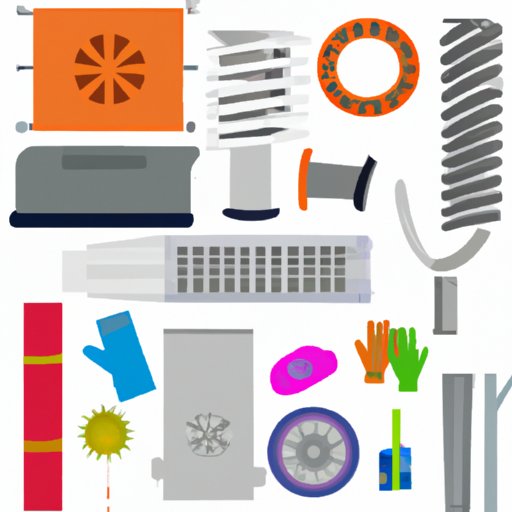Introduction
A dryer is an appliance used to remove moisture from clothing and other fabrics. It works by circulating hot air around the items being dried. Unfortunately, dryers can malfunction due to a variety of reasons, such as lint buildup, broken belts, or faulty thermostats. Fortunately, there are several easy steps you can take to diagnose and repair most common dryer problems.

Clean the Lint Trap Regularly
One of the easiest and most important ways to keep your dryer running smoothly is to regularly clean the lint trap. To do this, open the lint trap door and carefully remove any lint that has accumulated. Then, use a vacuum cleaner with a hose attachment to thoroughly clean out the lint trap and surrounding areas. This will help ensure that the hot air can circulate freely and prevent potential fire hazards.
Cleaning the lint trap regularly also helps improve the efficiency of your dryer. By removing lint buildup, the dryer will be able to dry clothes faster and use less energy. This can lead to significant savings on your energy bills over time.
Check the Exhaust Vent for Obstructions
The exhaust vent is responsible for carrying the hot, moist air from the dryer to the outside of your home. If this vent becomes blocked or obstructed, it can cause the dryer to malfunction. To check the vent, start by disconnecting the dryer from the power source. Then, remove the vent cover on the outside of your home and inspect the vent for any blockages. Common sources of obstruction include bird nests, leaves, and lint.
If you find any obstructions in the vent, carefully remove them and then reconnect the dryer to the power source. This should help restore normal functioning to the dryer.
Replace the Dryer Belt
The dryer belt is responsible for turning the drum during the drying cycle. If this belt becomes worn or frayed, it can cause the dryer to malfunction. To replace the belt, start by unplugging the dryer from the power source. Then, locate the belt and gently pull it off the pulleys. Next, install the new belt onto the pulleys and make sure it is properly tensioned.
Replacing the dryer belt regularly can help ensure that the dryer runs efficiently and safely. It can also help reduce wear and tear on the motor and other components, which can extend the life of the dryer.
Clean the Dryer Drum
Over time, lint and other debris can accumulate in the dryer drum. This can cause the dryer to run inefficiently and can even lead to a fire hazard. To clean the drum, first unplug the dryer from the power source. Then, use a damp cloth to wipe down the inside of the drum. Make sure to get into all the nooks and crannies. Finally, use a vacuum cleaner with a hose attachment to thoroughly clean the drum.
Cleaning the dryer drum regularly can help ensure that the dryer runs efficiently and safely. It can also help reduce wear and tear on the motor and other components, which can extend the life of the dryer.
Test the Thermal Fuse
The thermal fuse is a safety device that will shut off the dryer if it gets too hot. If this fuse fails, the dryer may not heat up properly or may stop working altogether. To test the thermal fuse, first unplug the dryer from the power source. Then, locate the thermal fuse and use a multimeter to test for continuity. If there is no continuity, then the fuse needs to be replaced.
Testing the thermal fuse regularly can help ensure that the dryer runs safely. It can also help prevent potential fire hazards caused by overheating.
Check the Cycling Thermostat
The cycling thermostat is responsible for regulating the temperature of the dryer. If this thermostat fails, the dryer may not heat up properly or may stop working altogether. To check the cycling thermostat, first unplug the dryer from the power source. Then, locate the thermostat and use a multimeter to test for continuity. If there is no continuity, then the thermostat needs to be replaced.
Checking the cycling thermostat regularly can help ensure that the dryer runs efficiently and safely. It can also help reduce wear and tear on the motor and other components, which can extend the life of the dryer.
Inspect the Heating Element
The heating element is responsible for providing heat to the dryer. If this element fails, the dryer may not heat up properly or may stop working altogether. To inspect the heating element, first unplug the dryer from the power source. Then, remove the heating element and inspect it for any signs of damage. If the element is damaged, it needs to be replaced.
Inspecting the heating element regularly can help ensure that the dryer runs efficiently and safely. It can also help reduce wear and tear on the motor and other components, which can extend the life of the dryer.
Conclusion
Maintaining your dryer is essential for keeping it running properly and safely. By cleaning the lint trap, checking the exhaust vent, replacing the dryer belt, cleaning the dryer drum, testing the thermal fuse, checking the cycling thermostat, and inspecting the heating element, you can ensure that your dryer runs efficiently and safely. Taking these steps can also help extend the life of your dryer and save you money on energy bills in the long run.


